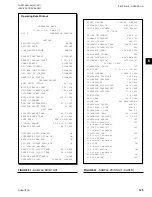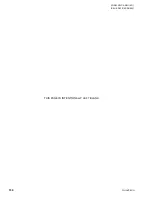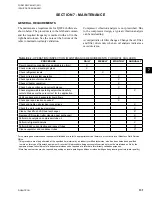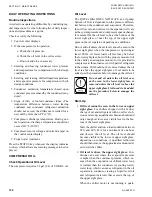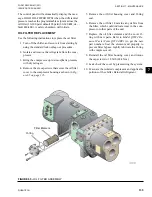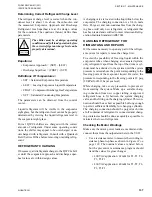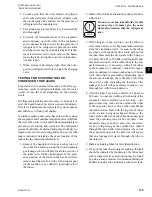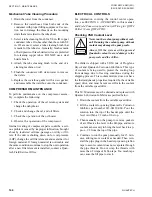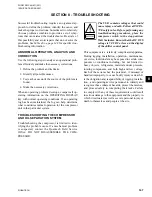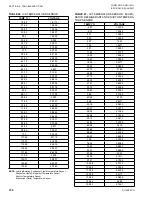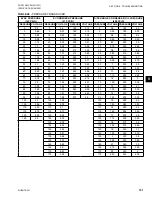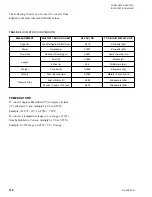
QUANTECH
139
SECTION 7 - MAINTENANCE
FORM QWC4-NM1 (221)
ISSUE DATE: 02/28/2021
7
2. To make sure that the concentration of refriger-
ant reached all parts of the system, slightly open
the oil charging valve and test for the presence of
refrigerant with a leak detector.
3. Test around each joint and factory weld carefully
and thoroughly.
4. To check for refrigerant leaks in the evaporator
and condenser, open the vents in the evaporator
and condenser heads and test for the presence of
refrigerant. If no refrigerant is present, the tubes
and tube sheets may be considered tight. If refrig-
erant is detected at the vents, remove the heads,
locate the leak, (using the soap test or leak detec-
tor) and repair.
5. When system is absolutely tight, blow the nitro-
gen and refrigerant mixture through the charging
valve.
TESTING FOR EVAPORATOR AND
CONDENSER TUBE LEAKS
Evaporator and condenser tube leaks in R-134a sys-
tems may result in refrigerant leaking into the water
circuit, or into the shell, depending on the pressure
levels.
If refrigerant is leaking into the water, it can be detect-
ed at the liquid head vents after a period of shutdown.
If water is leaking into the refrigerant, system capacity
and efficiency will drop off sharply.
If a tube is leaking and water has entered the system,
the evaporator and condenser should be valved off from
the rest of the water circuit and drained immediately to
prevent severe rusting and corrosion. The refrigerant
system should then be drained and purged with dry ni-
trogen to prevent severe rusting and corrosion. If a tube
leak is indicated, determine the exact location of the
leak using the following information:
1. Remove the heads and listen at each section of
the tubes for a hissing sound that would indicate
gas leakage, which will help locate the section of
the tubes to be further investigated. If the prob-
able location of the leaky tubes has been deter-
mined, treat that section in the following manner
(if the location is not definite, investigate all of
the tubes).
2.
Wash off both tube heads and the ends of all tubes
with water.
Do not use carbon tetrachloride for this
purpose since its fumes give the same
flame discoloration that the refrigerant
does.
3. With nitrogen or dry air, blow out the tubes to
clear them of traces of refrigerant laden moisture
from the circulation water. As soon as the tubes
are clear, a cork should be driven into each end of
the tube. Pressurize the dry system with 50 psig to
100 psig (345 kPa to 690 kPa) of nitrogen. Repeat
this process with all of the other tubes in the sus-
pected section or, if necessary, with all the tubes
in the evaporator or condenser. Allow the evapo-
rator or condenser to remain corked up to 12 hours
to 24 hours before proceeding. Depending upon
the amount of leakage, the corks may blow from
the end of a tube, indicating the location of the
leakage. If not, if will be necessary to make a very
thorough test with the leak detector.
4. After the tubes have been corked for 12 hours to
24 hours, two people working at both ends of the
evaporator must carefully test each tube – one
person removing corks at one end and the other
at the opposite end to remove corks and handle
the leak detector. Start with the top row of tubes
in the section being investigated. Remove the
corks at the ends of one tube simultaneously and
insert the exploring tube for five seconds – this
should be long enough to draw into the detec-
tor any refrigerant gas that might have leaked
through the tube walls. A fan placed at the end of
the evaporator opposite the detector will assure
that any leakage will travel through the tube to
the detector.
5.
Mark any leaking tubes for later identification.
6. If any of the tube sheet joints are leaking, the leak
should be indicated by the detector. If a tube sheet
leak is suspected, its exact location may be found
by using a soap solution. A continuous buildup of
bubbles around a tube indicates a tube sheet leak.
Summary of Contents for QWC4
Page 14: ...QUANTECH 14 FORM QWC4 NM1 221 ISSUE DATE 02 28 2021 THIS PAGE IS INTENTIONALLY LEFT BLANK...
Page 64: ...QUANTECH 64 FORM QWC4 NM1 221 ISSUE DATE 02 28 2021 THIS PAGE IS INTENTIONALLY LEFT BLANK...
Page 82: ...QUANTECH 82 FORM QWC4 NM1 221 ISSUE DATE 02 28 2021 THIS PAGE IS INTENTIONALLY LEFT BLANK...
Page 130: ...QUANTECH 130 FORM QWC4 NM1 221 ISSUE DATE 02 28 2021 THIS PAGE IS INTENTIONALLY LEFT BLANK...
Page 146: ...QUANTECH 146 FORM QWC4 NM1 221 ISSUE DATE 02 28 2021 THIS PAGE IS INTENTIONALLY LEFT BLANK...
Page 152: ...QUANTECH 152 FORM QWC4 NM1 221 ISSUE DATE 02 28 2021 THIS PAGE IS INTENTIONALLY LEFT BLANK...
Page 155: ...QUANTECH 155 NOTES...

